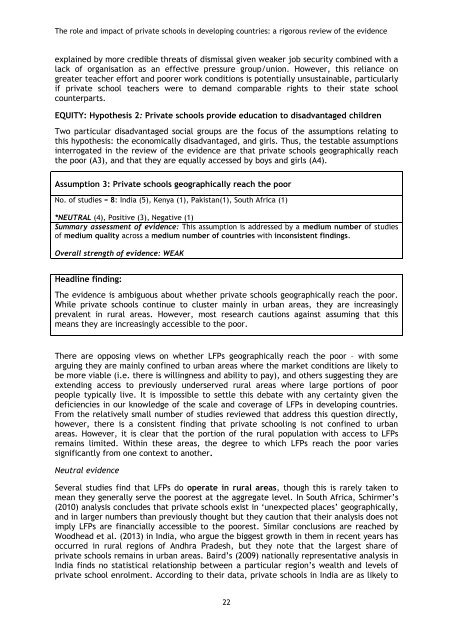private-schools-full-report
private-schools-full-report
private-schools-full-report
Create successful ePaper yourself
Turn your PDF publications into a flip-book with our unique Google optimized e-Paper software.
The role and impact of <strong>private</strong> <strong>schools</strong> in developing countries: a rigorous review of the evidence<br />
explained by more credible threats of dismissal given weaker job security combined with a<br />
lack of organisation as an effective pressure group/union. However, this reliance on<br />
greater teacher effort and poorer work conditions is potentially unsustainable, particularly<br />
if <strong>private</strong> school teachers were to demand comparable rights to their state school<br />
counterparts.<br />
EQUITY: Hypothesis 2: Private <strong>schools</strong> provide education to disadvantaged children<br />
Two particular disadvantaged social groups are the focus of the assumptions relating to<br />
this hypothesis: the economically disadvantaged, and girls. Thus, the testable assumptions<br />
interrogated in the review of the evidence are that <strong>private</strong> <strong>schools</strong> geographically reach<br />
the poor (A3), and that they are equally accessed by boys and girls (A4).<br />
Assumption 3: Private <strong>schools</strong> geographically reach the poor<br />
No. of studies = 8: India (5), Kenya (1), Pakistan(1), South Africa (1)<br />
*NEUTRAL (4), Positive (3), Negative (1)<br />
Summary assessment of evidence: This assumption is addressed by a medium number of studies<br />
of medium quality across a medium number of countries with inconsistent findings.<br />
Overall strength of evidence: WEAK<br />
Headline finding:<br />
The evidence is ambiguous about whether <strong>private</strong> <strong>schools</strong> geographically reach the poor.<br />
While <strong>private</strong> <strong>schools</strong> continue to cluster mainly in urban areas, they are increasingly<br />
prevalent in rural areas. However, most research cautions against assuming that this<br />
means they are increasingly accessible to the poor.<br />
There are opposing views on whether LFPs geographically reach the poor – with some<br />
arguing they are mainly confined to urban areas where the market conditions are likely to<br />
be more viable (i.e. there is willingness and ability to pay), and others suggesting they are<br />
extending access to previously underserved rural areas where large portions of poor<br />
people typically live. It is impossible to settle this debate with any certainty given the<br />
deficiencies in our knowledge of the scale and coverage of LFPs in developing countries.<br />
From the relatively small number of studies reviewed that address this question directly,<br />
however, there is a consistent finding that <strong>private</strong> schooling is not confined to urban<br />
areas. However, it is clear that the portion of the rural population with access to LFPs<br />
remains limited. Within these areas, the degree to which LFPs reach the poor varies<br />
significantly from one context to another.<br />
Neutral evidence<br />
Several studies find that LFPs do operate in rural areas, though this is rarely taken to<br />
mean they generally serve the poorest at the aggregate level. In South Africa, Schirmer’s<br />
(2010) analysis concludes that <strong>private</strong> <strong>schools</strong> exist in ‘unexpected places’ geographically,<br />
and in larger numbers than previously thought but they caution that their analysis does not<br />
imply LFPs are financially accessible to the poorest. Similar conclusions are reached by<br />
Woodhead et al. (2013) in India, who argue the biggest growth in them in recent years has<br />
occurred in rural regions of Andhra Pradesh, but they note that the largest share of<br />
<strong>private</strong> <strong>schools</strong> remains in urban areas. Baird’s (2009) nationally representative analysis in<br />
India finds no statistical relationship between a particular region’s wealth and levels of<br />
<strong>private</strong> school enrolment. According to their data, <strong>private</strong> <strong>schools</strong> in India are as likely to<br />
22


